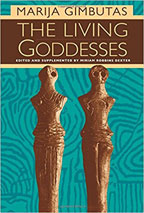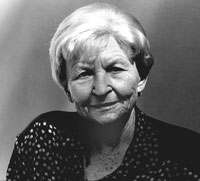|
From the ‘Burn Your Bra’ generation to the current ‘Pink Pussycat Hatters’, American women’s irreverence is still
trying to turn social injustice into recognition and respect for their rights. As the pendulum swings many of the legal, reproductive, cultural and political gains won via the
Women’s Liberation Movement in the 1960s are being challenged. In the protests during the Women’s March on Washington on January 21, 2017 and the rallies on
International Women’s Day on March 8, 2017, women around the world have begun to fight back.
In the 1990s, I was involved in the Goddess Movement that spearheaded awareness of patriarchal dominance in world religions. I revered its scholars,
reading the books of Margaret Starbird - “The Woman with the Alabaster Jar” who championed the idea of Mary Magdalene as the bride of Christ, Elaine Pagels author of
“The Gnostic Gospels” and Vicki Noble’s “The Double Goddess”. I was friends with spiritual feminist scholars, architect Mimi Lobell and artist
Cristina Biaggi.
These women, who were shedding light on the divine feminine while being debunked by traditional academics for challenging canon and proving that
ancient cultural artifacts were indeed testaments of Great Mother Goddess worship, are now cast in the shadow of time and barely remembered. I believe the road to true power
requires more than political change but also reflection on a higher vision of female identity.
The Living Goddesses
By Marija Gimbutas
Edited by Miriam Roberts Dexter
 Ever since I attended the Memorial Service for Marija Gimbutas held at Manhattan's Friends
Meeting House on May 7, 1994, both she and the Goddess have been in my life in a profound way. My memory of the event has faded, but what
remains in mind are the testimonies of architect Mimi Lobell, actress Olympia Dukakis and artist Cristina Biaggi, who spoke of Marija's warmth
and indefatigable scholarship in bringing to light the Goddess cultures that flourished thousands of years ago. Mimi Lobell
shared her remarks, "I first knew of Marija Gimbutas as a Scholarly Resource - as the foremost authority on the Indo-
Europeans, those Iron Age charioteers who ravaged the Goddess Civilizations of the Old World. In the mid 1970's I got her book
“The Goddesses and Gods of Old Europe”. Ever since I attended the Memorial Service for Marija Gimbutas held at Manhattan's Friends
Meeting House on May 7, 1994, both she and the Goddess have been in my life in a profound way. My memory of the event has faded, but what
remains in mind are the testimonies of architect Mimi Lobell, actress Olympia Dukakis and artist Cristina Biaggi, who spoke of Marija's warmth
and indefatigable scholarship in bringing to light the Goddess cultures that flourished thousands of years ago. Mimi Lobell
shared her remarks, "I first knew of Marija Gimbutas as a Scholarly Resource - as the foremost authority on the Indo-
Europeans, those Iron Age charioteers who ravaged the Goddess Civilizations of the Old World. In the mid 1970's I got her book
“The Goddesses and Gods of Old Europe”.  Here was Marija, an internationally respected female professor
of Archeology at UCLA, a mother of three and published author who had the courage to listen to Goddess voices AND who had the skill to convey their message both to
the public and that hostile male secret society: the Academy." Here was Marija, an internationally respected female professor
of Archeology at UCLA, a mother of three and published author who had the courage to listen to Goddess voices AND who had the skill to convey their message both to
the public and that hostile male secret society: the Academy."
For these women, myself and many feminists who sensed a deep spiritual depravity in our patriarchal society, Marija
authenticated the other side of history. We embraced her ground breaking premise that, "In Old Europe the focus of religion encompassed birth, nurturing, growth, death and
regeneration... The people of this era pondered untamed natural forces as well as wild plant and animal cycles and they worshipped goddesses in many forms. She revealed herself in
multiple ways through the myriad facets of life and she is depicted in a very complex symbolism."
Marija's studied archaic remains from the Neolithic age (7,000 - 3,000 BC), Bronze Age (2,500 - 1,500 BC) through the First
Millennium in what would now include the landmass from Sweden to Spain and Western Russia to the Greek Isles. She identified the "Kurgans" as Indo-European warrior tribes
originating in the Caucasus who migrated and then assimilated with agrarian, Goddess worshipping, matrilineal cultures. The
Kurgans imposed their patrilineal chiefdoms and male deities on the peoples they conquered, changing their religions forever.
Marija's theories, which challenged traditional perceptions of European prehistory, have met with great controversy as well as
enthusiasm. In countless articles, her best-known books, (“The Language of the Goddess” 1989 and “The Civilization of the
Goddess” 1991), as well as excavations in Yugoslavia, Greece and Italy, Marija developed her concepts from studies of female
oriented forms and symbols. Synthesizing her background in archaeology, linguistics, folklore and mythology into an
interpretive approach she called "archeomythology", Marija's work has proved valuable not only in itself, but as canon for future research.
Editor, Miriam Dexter Robbins was asked to complete “The Living Goddess” which is the last material Marija Gimbutas
worked on before her death. This book integrates Marija's early work in addition to presenting new research. In unembellished
prose that cuts to bone, Marija recreates structural models of matrilineal societies, Goddess myth and linguistic inheritance.
In Part I "Religion in Prepatriarchal Europe", are chapters on 1) Images of Goddesses and Gods, 2) Symbols, Signs and Sacred
Script, 3) The Tomb and the Womb, 4) Temple, 5) Sacred Stone and Wood Ceremonial Centers, and 6) Matrilineal Social Structure as Mirrored in Religion and Myth. The first chapter
loosely categorizes groups of Goddesses based on the shape of statuettes and their inscriptions. The art of firing ceramics began
around 7,000 BC and the variety of religious forms Marija deciphered include the birth-giving goddess, the mother and child goddess, the nursing goddess, the bear and deer goddess,
the double goddess, the bird goddess and the frog goddess. She wrote, "The goddess of birth and life was also a goddess of death
and regeneration. She represented the full cycle of the life continuum. Representation of the death goddess imbued with
the promise of new life reminds us that the cycle was a totality." Not only did these goddesses serve as the ancestral paradigms
for later mythologies, but their primal imagery is so vivid it can be traced to our own cultural icons. Of all the images of Marilyn
Monroe, the one that has most captured popular imagination is of her holding her skirt blown up by the wind. In her explanation
of the frog goddess, Marija wrote "Baubo is the goddess who displays her vulva, sometimes raising her skirt in a ritual that possibly dates to the Neolithic."
In Part II, "The Living Goddess” the chapters are 7) The Minoan Religion in Crete, 8) the Greek Religion, 9) the Etruscan Religion
, 10) the Basque Religion, 11) The Celtic Religion, 12) the Germanic Religion, and 13) The Baltic Religion. In her chapter on
Greek Religion, Marija wrote "During the Neolithic millennia, goddesses controlled birth giving, life sustenance, death bringing
and regeneration. The Old European goddesses carried out these functions powerfully... By classical times, the Old European Goddesses were eroticized, militarized to various
degrees (especially Athena) and made subservient to the gods." Marija traces the origins of later, more familiar Goddesses to
their roots in Neolithic times. "Different aspects of the Neolithic pregnant vegetation Goddess can be recognized in Demeter, the
queen of grain as well as her daughter, Persephone, who is both grain maiden and queen of the dead... Demeter and Persephone
are sometimes called the Demetres, a name that stresses the oneness of their divinity... In fact, the two images represent one
goddess in two guises, her older and younger aspects. The story of Demeter and Persephone recalls much earlier Neolithic
depictions of the two goddesses, or the goddess portrayed as Siamese twins. It is likely that the double images and temples
symbolize spring-summer and fall-winter seasons in a cycle of constant renewal."
Although conceived many years earlier, perhaps “The Living Goddess” was meant to appear in 1999 midst the confusion over
the plethora of predicted natural disasters and millennium madness. In her last chapter, Marija discusses the Goddesses
and folklore of her beloved Lithuanian homeland. In her section on Zemyna, the Lithuanian Earth Mother, Marija wrote, "Earth
is justice, the social conscience, as represented by the Greek Themis, Russian Mat'Syra Zemlya and Lithuanian Zemyna. The
earth mother listens to appeals, settles problems, and punishes all who deceive or disrespect her. She does not tolerate thieves,
liars, or vain or proud people. In legends and tales, sinners are devoured by the earth, along with their houses or castles, the
earth closes over them, and a lake or mountain appears on the site." Marija Gimbutas’ legacy is still being discovered. As we
experience ecological devastation, perhaps the Goddess voices are the ones we should listen to and revere.
|